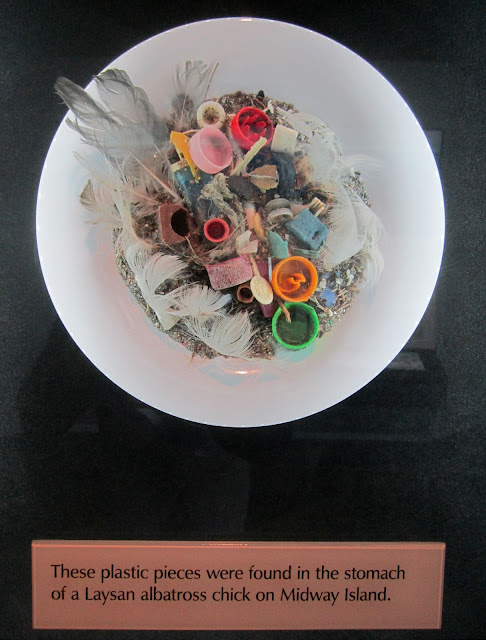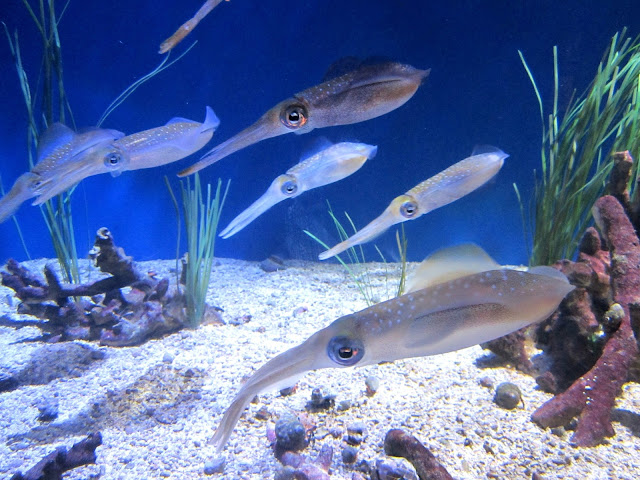Monterey Bay Aquarium
I may never (correction: will almost certainly never) scuba dive in a kelp forest. But with the help of the world-class facilities at Monterey Bay Aquarium, naturalists of all ages and skill levels can experience the wonder of the magnificent ocean ecosystems, from an underwater forest to the open seas, to rocky shores, without even getting wet (unless you really want to). Yesterday, I had the privilege of spending the day exploring the ever-fascinating Monterey Bay Aquarium.
For a naturalist, there is nothing more thrilling than exploring nature hands-on, in the elements, feeling the raw power of nature, the delicate balance of ecosystems. A close second, however, is exploring nature in a more controlled setting that is designed to facilitate learning, such as a museum, aquarium, or lab. And because most of us are not marine biologists with scuba certifications, the Monterey Bay Aquarium is our portal to the fascinating underwater world.
Not only is the Monterey Bay Aquarium the premier destination for marine biology enthusiasts on the Central Coast of California, it is also a facility that is leading the way in ocean conservation. The message is clear: the value of healthy oceans is immense, and the responsibility to keep them healthy, or more accurately restore their health, is ours.
Most visitors are smitten by the adorable sea otters and waddling penguins, mesmerized by the jellyfish and awed by the vast open sea and towering kelp forest exhibits. And that is wonderful; inspiring an awe and respect for the ocean is the first step. People will protect what they care about. But for me, the take-home message was found in a couple of more out-of-the-way exhibits: one on plastic pollution in our oceans, another on overfishing.
Baby sea otters suffocating in plastic bags and sea bird chicks turning up dead with stomachs full of pieces of plastic may not be popular topics for drawing a crowd, but they are valuable, painful lessons we need to learn.
Overfishing and under appreciation present a dire situation for sharks in all of our seas. Most people aren't even aware that this is happening.
Visit the aquarium, if you get the chance. Read and listen and learn about the plight of our oceans. Educate yourself and your family; learn to make wise choices. (The aquarium's Sea Food Watch program is a great help for consumers. View and download the guide here.)
Be enchanted by the sea, and let yourself be changed by it.
Like the rest of the earth, it is not a dumping ground for our waste, but a delicate and beautiful ecosystem, teeming with a remarkable variety of life.
Some frugal (and eco-friendly) tips for visiting Monterey Bay Aquarium:
Check for coupons, or ask for gifts cards to the aquarium for birthdays or Christmas. Tickets are pricey, but there are a couple of ways to reduce that cost.
Don't pay for parking. Parking in the immediate vicinity of the aquarium comes at a premium. It will save you a considerable chunk of change if you park a littler farther away, in a free parking spot along the ocean, and walk. The walk along the bay is gorgeous anyway!
Pack a picnic lunch. The aquarium has its own café/restaurant, and there are no shortage of dining options along Cannery Row, but they will cost you. The aquarium has a lovely spot outside for picnickers; pack some sandwiches, reusable water bottles and snacks in a backpack, and enjoy a picnic overlooking the bay.
Plan on spending the whole day at the aquarium. Generally, doors open at 10am and close at 5pm. Spend the whole seven hours there, and your money will be well-spent. Take time to see all of the exhibits, as well as special demonstrations. Photograph signs with valuable information, if you're a nature nerd like me, so you will have that information available to you later, long after you've left the aquarium.
Along the same vein, plan for efficiency. Look at a map of the aquarium beforehand, as well as the day's schedule of events. Decide what you want to see, and plan out when you need to be in certain parts of the aquarium. Some people may prefer to just "go with the flow" and be content with seeing whatever they stumble upon. I, on the other hand, prefer a more structured approach!
Bonus savings: When the aquarium closes and your thoughts are turning toward dinner, have a plan! You know you're going to be hungry at dinner time, after all. A favorite Monterey treat for us is clam chowder in a bread bowl; a cost-saving option is to bring sourdough bread from home along with a thermos of clam chowder (On sale for $0.99 per can? Yes please!) and have another ocean-side picnic as the sun sets. The views can't be beat!
For a naturalist, there is nothing more thrilling than exploring nature hands-on, in the elements, feeling the raw power of nature, the delicate balance of ecosystems. A close second, however, is exploring nature in a more controlled setting that is designed to facilitate learning, such as a museum, aquarium, or lab. And because most of us are not marine biologists with scuba certifications, the Monterey Bay Aquarium is our portal to the fascinating underwater world.
 |
| Leopard Shark in the kelp forest exhibit |
Most visitors are smitten by the adorable sea otters and waddling penguins, mesmerized by the jellyfish and awed by the vast open sea and towering kelp forest exhibits. And that is wonderful; inspiring an awe and respect for the ocean is the first step. People will protect what they care about. But for me, the take-home message was found in a couple of more out-of-the-way exhibits: one on plastic pollution in our oceans, another on overfishing.
Baby sea otters suffocating in plastic bags and sea bird chicks turning up dead with stomachs full of pieces of plastic may not be popular topics for drawing a crowd, but they are valuable, painful lessons we need to learn.
Overfishing and under appreciation present a dire situation for sharks in all of our seas. Most people aren't even aware that this is happening.
Visit the aquarium, if you get the chance. Read and listen and learn about the plight of our oceans. Educate yourself and your family; learn to make wise choices. (The aquarium's Sea Food Watch program is a great help for consumers. View and download the guide here.)
Be enchanted by the sea, and let yourself be changed by it.
Like the rest of the earth, it is not a dumping ground for our waste, but a delicate and beautiful ecosystem, teeming with a remarkable variety of life.
Some frugal (and eco-friendly) tips for visiting Monterey Bay Aquarium:
Check for coupons, or ask for gifts cards to the aquarium for birthdays or Christmas. Tickets are pricey, but there are a couple of ways to reduce that cost.
Don't pay for parking. Parking in the immediate vicinity of the aquarium comes at a premium. It will save you a considerable chunk of change if you park a littler farther away, in a free parking spot along the ocean, and walk. The walk along the bay is gorgeous anyway!
Pack a picnic lunch. The aquarium has its own café/restaurant, and there are no shortage of dining options along Cannery Row, but they will cost you. The aquarium has a lovely spot outside for picnickers; pack some sandwiches, reusable water bottles and snacks in a backpack, and enjoy a picnic overlooking the bay.
Plan on spending the whole day at the aquarium. Generally, doors open at 10am and close at 5pm. Spend the whole seven hours there, and your money will be well-spent. Take time to see all of the exhibits, as well as special demonstrations. Photograph signs with valuable information, if you're a nature nerd like me, so you will have that information available to you later, long after you've left the aquarium.
Along the same vein, plan for efficiency. Look at a map of the aquarium beforehand, as well as the day's schedule of events. Decide what you want to see, and plan out when you need to be in certain parts of the aquarium. Some people may prefer to just "go with the flow" and be content with seeing whatever they stumble upon. I, on the other hand, prefer a more structured approach!
Bonus savings: When the aquarium closes and your thoughts are turning toward dinner, have a plan! You know you're going to be hungry at dinner time, after all. A favorite Monterey treat for us is clam chowder in a bread bowl; a cost-saving option is to bring sourdough bread from home along with a thermos of clam chowder (On sale for $0.99 per can? Yes please!) and have another ocean-side picnic as the sun sets. The views can't be beat!












Comments
Post a Comment